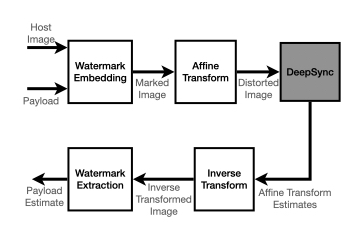
In the context of digital watermarking of images/video, template based techniques rely on the insertion of a signal template to aid recovery of the watermark after transforms (rotation, scale, translation, aspect-ratio) common in imaging workflows. Detection approaches for such techniques often rely on known signal properties when performing geometry estimation before watermark extraction. In deep watermarking, i.e., watermarking employing deep learning, focus so far has been on extraction methods that are invariant to geometric transforms. This results in a gap in precise geometry recovery and synchronization which compromises watermark recovery, including the recovery of information bits, i.e., the payload. In this work, we propose DeepSync, a novel deep learning approach aimed at enhancing watermark synchronization for both template-based and deep watermarks.


Spot colors are widely used in the food packaging industry. We wish to add a watermark signal within a spot color that is readable by a Point Of Sale (POS) barcode scanner which typically has red illumination. Some spot colors such as blue, black and green reflect very little red light and are difficult to modulate with a watermark at low visibility to a human observer. The visibility measurements that have been made with the Digimarc watermark enables the selection of a complementary color to the base color which can be detected by a POS barcode scanner but is imperceptible at normal viewing distance.


Recent advances in deep learning (DL) have led to great success in tasks of computer vision and pattern recognition. Sharing pre-trained DL models has been an important means to promote the rapid progress of research community and development of DL based systems. However, it also raises challenges to model authentication. It is quite necessary to protect the ownership of the DL models to be released. In this paper, we present a digital watermarking technique to deep neural networks (DNNs). We propose to mark a DNN by inserting an independent neural network that allows us to use selective weights for watermarking. The independent neural network is only used in the training phase and watermark verification phase, and will not be released publicly. Experiments have shown that, the performance of marked DNN on its original task will not be degraded significantly. Meantime, the watermark can be successfully embedded and extracted with a low neural network loss even under the common attacks including model fine-tuning and compression, which has shown the superiority and applicability of the proposed work.

To read a digital watermark from printed images requires that the watermarking system read correctly after affine distortions. One way to recover from affine distortions is to add a synchronization signal in the Fourier frequency domain and use this synchronization signal to estimate the applied affine distortion. If the synchronization signal contains a collection of frequency impulses, then a least squares match of frequency impulse locations results in a reasonably accurate linear transform estimation. Nearest neighbor frequency impulse peak location estimation provides a good rough estimate for the linear transform, but a more accurate refinement of the least squares estimate is accomplished with partial pixel peak location estimates. In this paper we will show how to estimate peak locations to any desired accuracy using only the complex frequencies computed by the standard DFT. We will show that these improved peak location estimates result in a more accurate linear transform estimate. We conclude with an assessment of detector robustness that results from this improved linear transformation accuracy.

This paper describes how watermarking technology can be used to prevent the proliferation of Deepfake news. In the proposed system, digital watermarks are embedded in the audio and video tracks of video clips of trusted news agencies at the time the videos are captured or before they are distributed. The watermarks are detected at the social media network’s portals, nodes, and back ends. The embedded watermark imparts a unique identifier to the video, that links it to a blockchain. The watermarks also allow video source tracking, integrity verification, and alteration localization. The watermark detectors can be standalone software applications, or they can be integrated with other applications. They are used to perform three main tasks: (1) they alert the internet user when he watches an inauthentic news video, so that he may discard it, (2) they prevent a Deepfake news video from propagating through the network (3) they perform forensic analysis to help track and remove Deepfake news video postings. The paper includes Proof-of- Concept simulation results.

